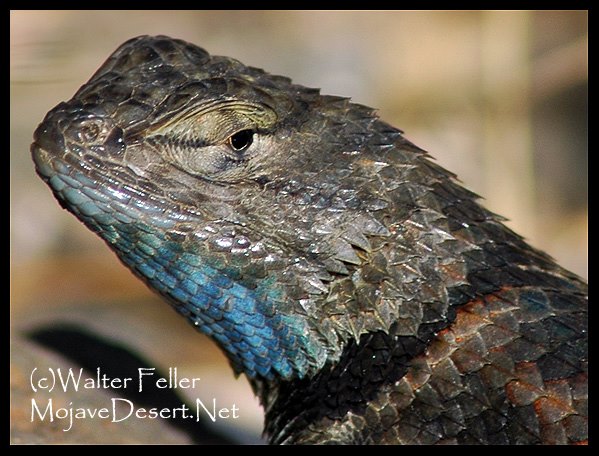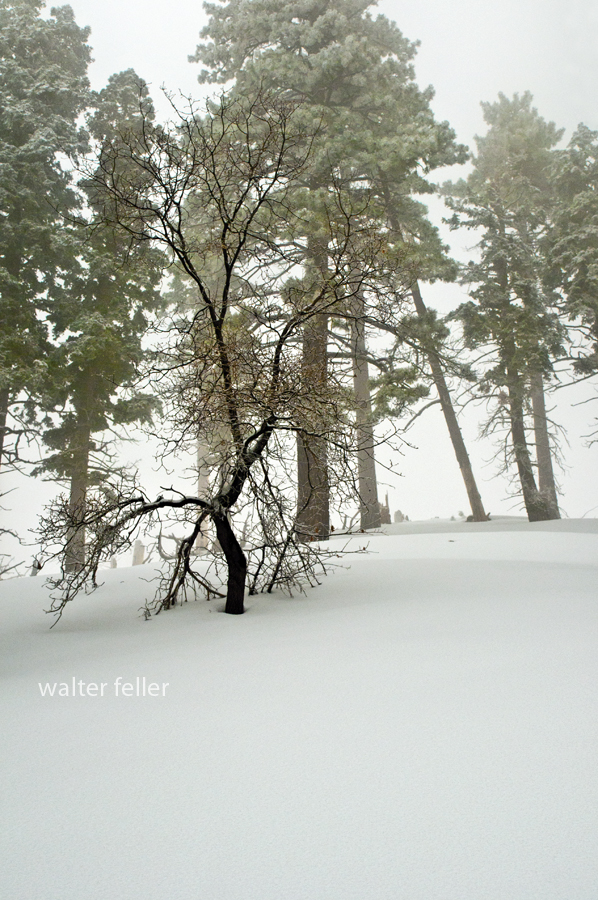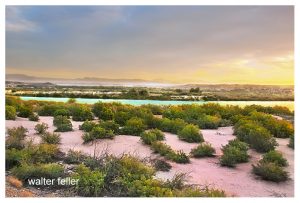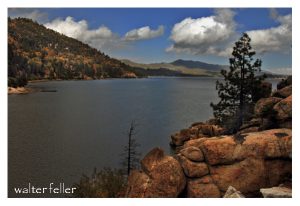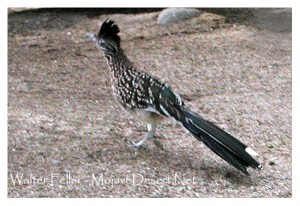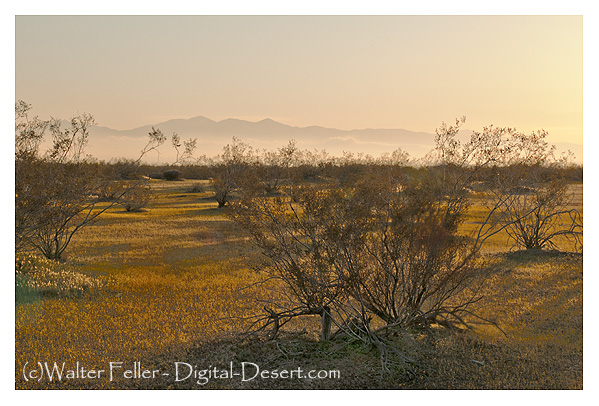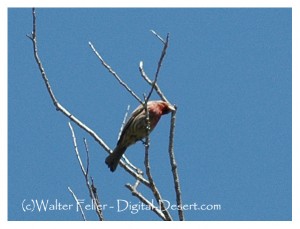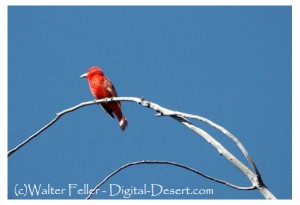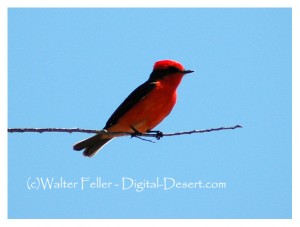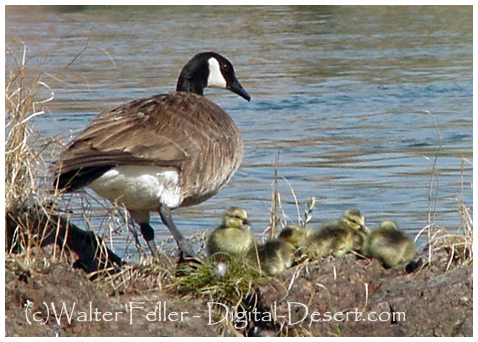in a vaguely woven forest
greens and grays
white and black
silver, of course.
a wayward band,
small birds, sparrows of some kind,
or tits perhaps.
flitting and fluttering in silence
from branch to branch to branch
their busy order
securing their place
briefly holding court
then disappearing
into a vaguely woven forest
.
.
Category Archives: Wildlife
Saltation
Thin clouds of purest white streaked through the crystalline sky miles above the dune as it glistened and glittered in the morning’s golden sunlight. The ever-present wind swirled out of its invisibility high above grazing the crests of each swell, placing a yellow halo at the crown of each and every rise. Soon, these phenomena broadened and covered everything leeward. Never just one grain but nearly an infinite amount of particles bouncing and flying over the top. The sandscape vibrating and flirting with focus and vision. Wave after wave, all as if it were applauding itself, this audience of at least trillions upon trillions upon trillions of its own. This is the way sand dunes travel and comfort themselves.
There is no apparent grand purpose other than subtle providence, yet, that is grand in itself.
After all the commotion, Bug, the darkling beetle, emerged from its hiding place an inch below the surface. Rat, arrived first, however, and it ate Bug. Then Hawk also swirled out of its invisibility high above in the crystal sky and snatched Rat with bloody talons flying off home to its ravenous brood.
Rat knew he had come to his end, for all rats die as does everything else that lives. Rat was pleased that it was Hawk that would consume him. Coyote or Snake would not honor him with such an aerial showing of the vast world he lived in before he was killed.
END
w.feller
END
w.feller
Trees
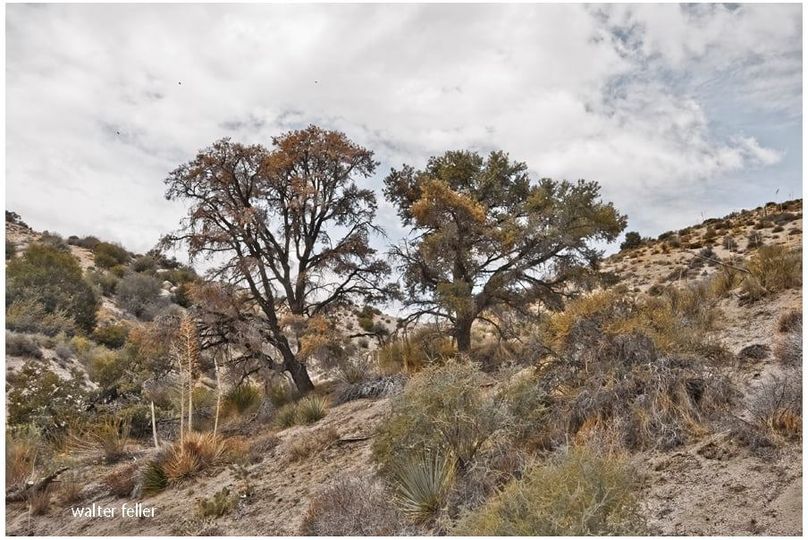
There are three ravens in the sky above the oak on the left. The raven on the far right of those three flew in front of me after first cawing and catching my attention. Over the years I have learned when this happens there are two ravens flying safely and quietly behind me. I like to believe they do this as a strategy to distract potential predators.
No Burro — No Gold
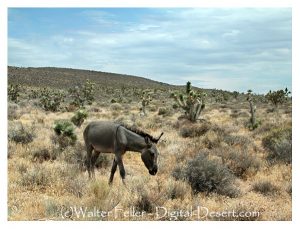
Feral ass
Sandy Walker, Desert Rat, says that in the desert a Ford lives 3 years – a dog 3 times the age of the Ford – 9, a horse 3 times the age of a dog – 27, and a man 3 times the age of the horse – 81, and some say a burro 3 times the age of a man – 243, at least this is 4/5ths true.
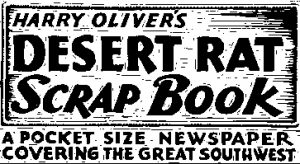 Sandy Walker says you can’t find gold with Fords – have to have burros. Says he’s been out here in the desert 26 years, 6 years hunting gold and 20 years hunting burros. He didn’t find his mine while hunting gold. He found it while hunting his dadburned runaway burros.
Sandy Walker says you can’t find gold with Fords – have to have burros. Says he’s been out here in the desert 26 years, 6 years hunting gold and 20 years hunting burros. He didn’t find his mine while hunting gold. He found it while hunting his dadburned runaway burros.
Many prospectors will tell you that no one has ever seen a dead burro.
—Printed first in “The Gold Miner,” 1930.
Uncommon to locally common in deserts of California. Range extends into eastern Lassen Co., and from extreme southern Mono Co. south to the Mexican border. Most are found in Inyo Co., northeastern San Bernardino Co., and in the vicinity of the Colorado River.
Lizard Love
“… Then I walked out of the bar room
Couldn’t even turn around
I guess I know what they were going to do
I knew what was going down
It’s not a long way from the dance floor to the dark of the parking lot
It’s kinda like love but it’s not.”
~ Kinda Like Love – Molly Hatchet
Observances one spring morning at Silverwood Lake

Ben the lizard perches upon his boulder puffing and pushing in the mid-morning sun hoping to attract an attractive lizard lady.
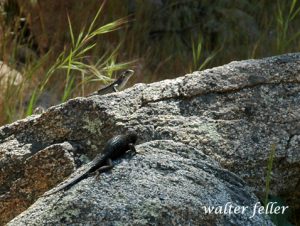
Ben spies the beautiful Paula along the ridge. Overcome with his little lizard emotions, he hesitates for an instant … she disappears. But, … he wants her.
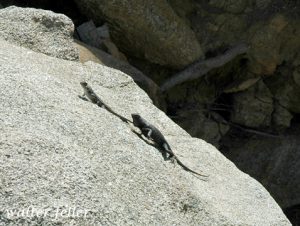
He is teased and vexed, so, her plan is working. She has captured his interest, and he follows– He is a tool.

Ben, with his eyes blurred with lascivious lust, lost his luscious lizard lady in a blink of all four of his little lizard eyelids.

Ben looks and looks again and again. He can smell the excellent fragrance of her seasonal readiness. They both have needs.
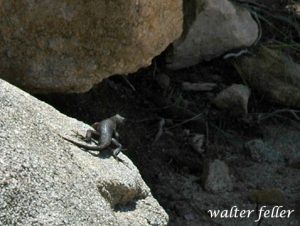
There is a flicker of shadow in the slice of sunlight between the granite boulders. He asks himself, “is that her?” “Could it be?” She certainly is pungent.

“Peek-a-boo,” her teeny lizard voice calls out to Ben in their little lizard language that only little lizards in lizard love can hear.
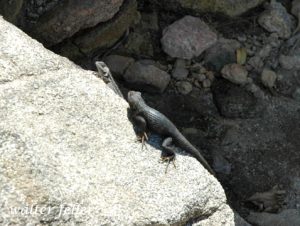
Paula holds still while wholly swollen Ben creeps carefully and kind of creepily toward her. He excretes his musk as dirty, dry, crystals of salt from his excreter thing and cautiously edges toward her.
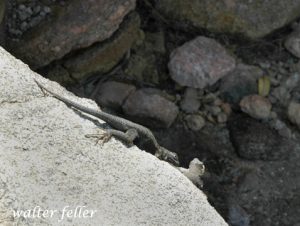
“This is it! This is really happening!” Ben’s teensy little lizard heart is pounding as they slip into the shadows to “do the deed.” There is a rustling in the leaves and rubble…

Their hot and heavy sexual activity finishes considerably sooner than they both anticipated–Ben just couldn’t seem to concentrate. Paula left shortly thereafter to go find bugs with her friends. Ben is spent and does one last, exhausted pushup with the sun on his back before taking a long, well-earned nap.
The End
The Raven
~ The Raven – Edgar Allen Poe – 1845
Once upon a midnight dreary, while I pondered, weak and weary,
Over many a quaint and curious volume of forgotten lore,
While I nodded, nearly napping, suddenly there came a tapping,
As of someone gently rapping, rapping at my chamber door.
” ‘Tis some visitor,” I muttered, “tapping at my chamber door;
Only this, and nothing more.”
Ah, distinctly I remember, it was in the bleak December,
And each separate dying ember wrought its ghost upon the floor.
Eagerly I wished the morrow; vainly I had sought to borrow
From my books surcease of sorrow, sorrow for the lost Lenore,.
For the rare and radiant maiden whom the angels name Lenore,
Nameless here forevermore.
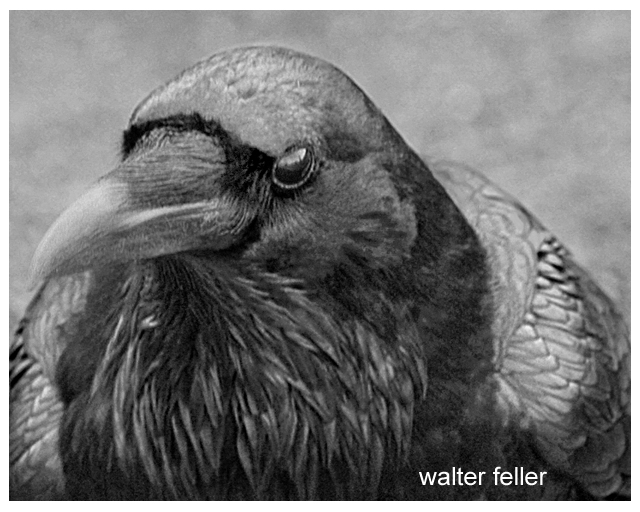
And the silken sad uncertain rustling of each purple curtain
Thrilled me—filled me with fantastic terrors never felt before;
So that now, to still the beating of my heart, I stood repeating,
” ‘Tis some visitor entreating entrance at my chamber door,
Some late visitor entreating entrance at my chamber door.
This it is, and nothing more.”
Presently my soul grew stronger; hesitating then no longer,
“Sir,” said I, “or madam, truly your forgiveness I implore;
But the fact is, I was napping, and so gently you came rapping,
And so faintly you came tapping, tapping at my chamber door,
That I scarce was sure I heard you.” Here I opened wide the door;—
Darkness there, and nothing more.
Deep into the darkness peering, long I stood there, wondering, fearing
Doubting, dreaming dreams no mortals ever dared to dream before;
But the silence was unbroken, and the stillness gave no token,
And the only word there spoken was the whispered word,
Lenore?, This I whispered, and an echo murmured back the word,
“Lenore!” Merely this, and nothing more.
Back into the chamber turning, all my soul within me burning,
Soon again I heard a tapping, something louder than before,
“Surely,” said I, “surely, that is something at my window lattice.
Let me see, then, what thereat is, and this mystery explore.
Let my heart be still a moment, and this mystery explore.
” ‘Tis the wind, and nothing more.”
Open here I flung the shutter, when, with many a flirt and flutter,
In there stepped a stately raven, of the saintly days of yore.
Not the least obeisance made he; not a minute stopped or stayed he;
But with mien of lord or lady, perched above my chamber door.
Perched upon a bust of Pallas, just above my chamber door,
Perched, and sat, and nothing more.
Then this ebony bird beguiling my sad fancy into smiling,
By the grave and stern decorum of the countenance it wore,
“Though thy crest be shorn and shaven thou,” I said, “art sure no craven,
Ghastly, grim, and ancient raven, wandering from the nightly shore.
Tell me what the lordly name is on the Night’s Plutonian shore.”
Quoth the raven, “Nevermore.”
Much I marvelled this ungainly fowl to hear discourse so plainly,
Though its answer little meaning, little relevancy bore;
For we cannot help agreeing that no living human being
Ever yet was blessed with seeing bird above his chamber door,
Bird or beast upon the sculptured bust above his chamber door,
With such name as “Nevermore.”
But the raven, sitting lonely on that placid bust, spoke only
That one word, as if his soul in that one word he did outpour.
Nothing further then he uttered; not a feather then he fluttered;
Till I scarcely more than muttered, “Other friends have flown before;
On the morrow he will leave me, as my hopes have flown before.”
Then the bird said, “Nevermore.”
Startled at the stillness broken by reply so aptly spoken,
“Doubtless,” said I, “what it utters is its only stock and store,
Caught from some unhappy master, whom unmerciful disaster
Followed fast and followed faster, till his songs one burden bore,—
Till the dirges of his hope that melancholy burden bore
Of “Never—nevermore.”
But the raven still beguiling all my sad soul into smiling,
Straight I wheeled a cushioned seat in front of bird, and bust and door;
Then, upon the velvet sinking, I betook myself to linking
Fancy unto fancy, thinking what this ominous bird of yore —
What this grim, ungainly, ghastly, gaunt and ominous bird of yore
Meant in croaking “Nevermore.”
Thus I sat engaged in guessing, but no syllable expressing
To the fowl, whose fiery eyes now burned into my bosom’s core;
This and more I sat divining, with my head at ease reclining
On the cushion’s velvet lining that the lamplight gloated o’er,
But whose velvet violet lining with the lamplight gloating o’er
She shall press, ah, nevermore!
Then, methought, the air grew denser, perfumed from an unseen censer
Swung by seraphim whose footfalls tinkled on the tufted floor.
“Wretch,” I cried, “thy God hath lent thee — by these angels he hath
Sent thee respite—respite and nepenthe from thy memories of Lenore!
Quaff, O quaff this kind nepenthe, and forget this lost Lenore!”
Quoth the raven, “Nevermore!”
“Prophet!” said I, “thing of evil!–prophet still, if bird or devil!
Whether tempter sent, or whether tempest tossed thee here ashore,
Desolate, yet all undaunted, on this desert land enchanted–
On this home by horror haunted–tell me truly, I implore:
Is there–is there balm in Gilead?–tell me–tell me I implore!”
Quoth the raven, “Nevermore.”
“Prophet!” said I, “thing of evil–prophet still, if bird or devil!
By that heaven that bends above us–by that God we both adore–
Tell this soul with sorrow laden, if, within the distant Aidenn,
It shall clasp a sainted maiden, whom the angels name Lenore—
Clasp a rare and radiant maiden, whom the angels name Lenore?
Quoth the raven, “Nevermore.”
“Be that word our sign of parting, bird or fiend!” I shrieked, upstarting–
“Get thee back into the tempest and the Night’s Plutonian shore!
Leave no black plume as a token of that lie thy soul hath spoken!
Leave my loneliness unbroken! — quit the bust above my door!
Take thy beak from out my heart, and take thy form from off my door!”
Quoth the raven, “Nevermore.”
And the raven, never flitting, still is sitting, still is sitting
On the pallid bust of Pallas just above my chamber door;
And his eyes have all the seeming of a demon’s that is dreaming.
And the lamplight o’er him streaming throws his shadow on the floor;
And my soul from out that shadow that lies floating on the floor
Shall be lifted—nevermore!
The Snake and the Frog
It was a dry year, and nothing was growing around Jim Craig’s diggings. Nor was there anything to eat anywhere in sight. Jim struck out for the Colorado River to get a mess of fish.
He got there and started digging for bait, but he could not find any worms. First thing he saw was snake with a frog in its mouth. Jim grabbed a forked stick and pried the frog away before the snake swallowed it. He was going to kill the snake, right then and there, but he changed his mind. He gave the snake a drink of whiskey and let it go.
Jim stuck the frog on his hook, made a cast, and yanked a big catfish from the river. Then, just as he began to look around for more bait, the same old snake came along with another frog. Right behind him, wriggling and twitching, were nine more snakes. And they all carried frogs. They dropped the products at Jim’s feet and then they held up their heads with their mouths wide open.
from Pioneer tales of San Bernardino County
WPA Writers’ Program – 1940
Bear Lake, Baldwin Lake and Big Bear Lake
in the summer of 1845, Benjamin D Wilson, own part of the interest in the Jurupa Rancho, site of the present city of Riverside, led a troop of Calvary in search of cattle rustlers.
Setting out from San Bernardino Valley, he divided his command. Most of the men he sent through Cajon Pass, keeping only 22 Mexican troopers with him to follow a trail across the mountains. Two days later, Wilson and his men reached the lake where they sighted scores of grizzly bears.
Most of the soldiers had been vaqueros. They formed in pairs and drew reatas, each pair attacking a bear. One looped a rope around bear’s neck; his companion roped same bear by a hind foot. Then the men drew apart to stretch the rope taut and hold the bear a prisoner. They bagged and skinned eleven bears, stretched their hides and continued across the mountains to join the rest of the command on the desert at Rancho Las Flores, on the Mojave River.
Here the reunited party engaged Indians in a fight, after which Wilson and his 22 vaquero-troopers returned home by the way of the lake. They again found the place overrun with bears, and the same 22 soldiers brought in eleven more bears– enough to give them a bear rug apiece as a trophy. It was then that Wilson gave the name of Bear Lake to the little body of water.
Years later the name was changed to Baldwin Lake. The name survives, however, in Big Bear Lake which was created in the site of the Talmadge Ranch in 1884 when a dam was built to provide a constant water supply for the Redlands District.
–
adapted from ~ Pioneer Tales of San Bernardino County – WPA – 1940.
American Avocet
A common to abundant winter visitor to salt ponds, fresh and saline emergent wetlands, and mudflat habitats throughout the Central Valley and the central and southern coastal areas. Breeds from March to mid-July, and is relatively common during this period in northeast California, the Central Valley, and coastal estuaries. Common most of the year at the Salton Sea, but only a few pairs have been known to nest.
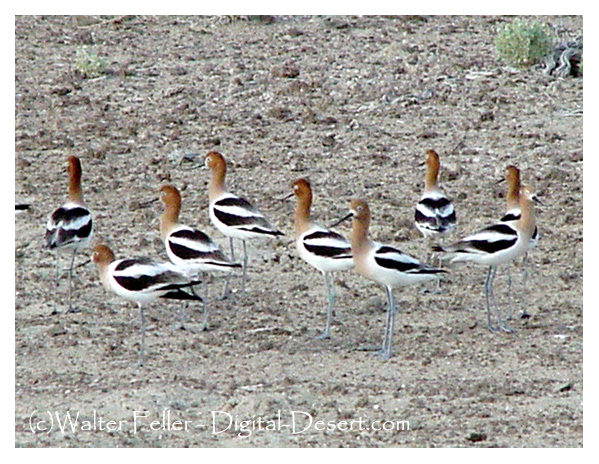
Forages on mudflats, salt or alkali flats, in shallow ponded areas with silt bottoms, and in salt pond. Feeds by probing in mud, sweeping bill through water or soupy mud, or by swimming and tipping-up like ducks. Preferred foods include aquatic insects, crustaceans, snails, worms, and occasionally seeds of aquatic plants
— State of California
These were spotted in the Saline Valley several hundred yards away from the salt lake shoreline. They would, randomly it seemed, all take off into the air, circle around and land in the same spot they left. I imagined that was an adaptation they have made to spot predators.
A gentleman coming from the Warm Springs walked up to me and we started talking. He told me this was a “lost” flock of American avocet that drifted into the valley long ago during a storm. They found the lake hospitable enough to stay — that every time they tried to leave, they just turned back after a short distance returning to the salt sink at the bottom of the basin that was now their home.
Maybe the guy was knowledgeable and truthful, but more likely he was passing along something he heard that was passed along by someone else who heard something and so on and so forth. You never know who you are talking to.
more about the American avocet
Where are They Now?
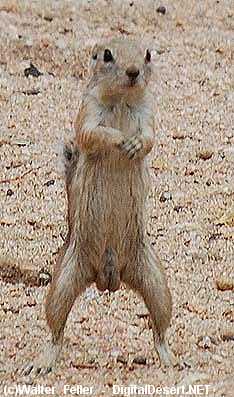
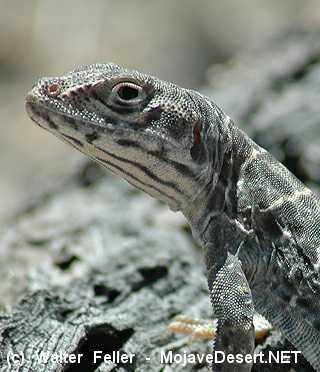
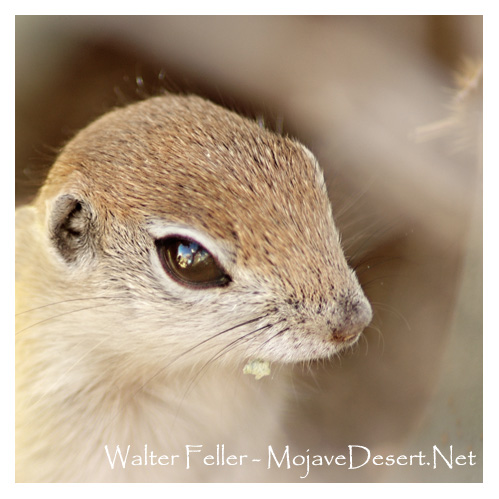
– b. unk. d October 12, 2013
Cause of death: eaten by red-tailed hawk.
Loving & Devoted Mother …
The following was written and recorded by E.C. Jaeger in 1922. I believe, although dated over 90 years ago, this behavior is just as relevant today as it was then, however, scaled down from our increasing intrusion into their ever-shrinking habitat:
If a female road-runner is approached when on the nest, she generally remains quiet until the intruder is right upon her; then she slips over the back of the nest and flies a short distance to safety, but where she can still see the unwelcome caller. At times she has been known to permit herself to be caught rather than forsake her young.
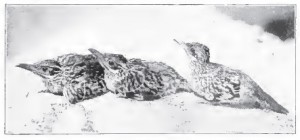
A member of the Cooper Ornithological Club (Mr. J. R. Pemberton) gives a most interesting report concerning the actions of a female roadrunner whose nest he found some ten feet above ground in a sycamore tree. As the observer began climbing up to the nest, the bird hopped to the ground.
“Immediately,” says Mr. Pemberton, “it began to squirm, scramble, and drag itself away across an open space and in full view. The bird was simulating a broken leg instead of a broken wing! The bird held its wings closed throughout the demonstration, though frequently falling over on its side in its enthusiasm. The whole performance was kept entirely in my view, the bird gradually working away from the tree until it was some thirty-five feet distant, when it immediately ran back to the base of the tree and repeated the whole show. I had been so interested up to now that I had failed to examine the nest, which, when looked into, contained five young probably a week old. When I got to the ground the bird continued its ‘stunt’ rather more frantically than before, and in order to encourage the bird, I followed and was pleased to see it remain highly consistent until I was decoyed to a point well outside the grove. Here the bird ran suddenly away at full speed and in a direction still away from the nest.”
Better Holes & Middens
Desert Woodrat
Neotoma lepida
Desert pack rat nests can be used by the same pack rat families for generations and generations.
This rodent is commonly known as the “pack rat” or “trade rat” named for collecting any shiny or metallic object it fancies. Its burrow is easily recognized by the rubbish littered about the entrance.
More about the wood rat:
https://digital-desert.com/wildlife/rodents/desert-woodrat.html
Snake Bite — Don’t Make it Worse

A description of events in one day in April of 2010 while I worked as a volunteer at the California State Poppy Reserve in Lancaster, CA.
I was working the trails one hazy midday when two very excited young gentlemen came running toward me and told me that their uncle had stepped on a snake and it had bit him. The uncle, limping badly, looked pasty-pale and with his friend and brother made their way into the visitor center after once again telling me the man had stepped on a snake. The victim’s brother (as I found out later) while closing the door whispered to me, “He didn’t step on it, he kicked it to get it out of his way.” First, I inspected the wound. Yep, it was a snake bite hole. Next, I asked if he knew what kind of snake it was, or what it may have looked like. He told me, “It looked like a snake. I told you that already.” I bit my lip. He was regaining color.
First, I inspected the wound. Yep, it was a snake bite hole. Next, I asked if he knew what kind of snake it was, or what it may have looked like. He told me, “It looked like a snake. I told you that already.” I bit my lip. He was regaining color.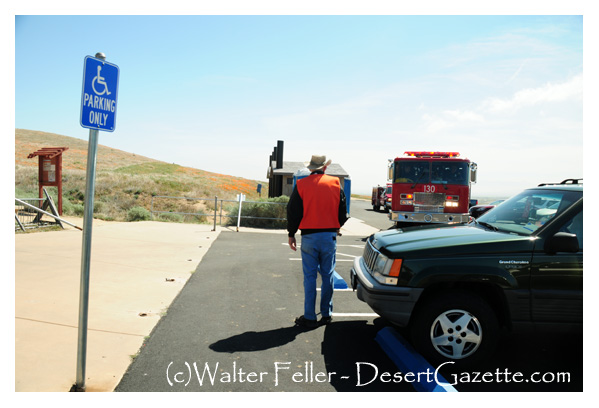 Since I’m not a doctor and I felt the patient was being a jerk I decided a medical professional would have to take it from this point. I called 911. It takes about 20 minutes or so for emergency response vehicles to get from Lancaster to the reserve. The dude was looking better and looking at me as if he expected me to suck the poison out of his leg. “Not my job,” I thought. There were other volunteers there that were far more capable than I, so I went out with my buddy Morris (Volunteer of the Year) to stand in the parking lot.
Since I’m not a doctor and I felt the patient was being a jerk I decided a medical professional would have to take it from this point. I called 911. It takes about 20 minutes or so for emergency response vehicles to get from Lancaster to the reserve. The dude was looking better and looking at me as if he expected me to suck the poison out of his leg. “Not my job,” I thought. There were other volunteers there that were far more capable than I, so I went out with my buddy Morris (Volunteer of the Year) to stand in the parking lot.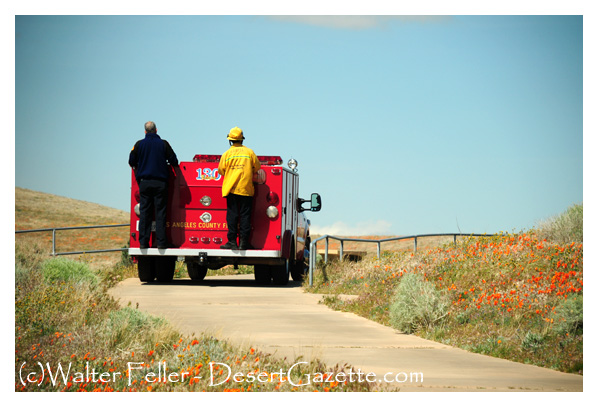 The fire truck came first with a support vehicle, whatever they call the service truck that follows. The fire truck couldn’t make it up the sidewalk to the visitor center, but the smaller truck could. I wanted to ride on the back too, but I didn’t ask. It looked like fun.
The fire truck came first with a support vehicle, whatever they call the service truck that follows. The fire truck couldn’t make it up the sidewalk to the visitor center, but the smaller truck could. I wanted to ride on the back too, but I didn’t ask. It looked like fun. The paramedic rushed into the building with about a dozen other personnel and did a triage-type-thing. Assessing the wound he confirmed my suspicions that it was a snake-made-hole in his leg.
The paramedic rushed into the building with about a dozen other personnel and did a triage-type-thing. Assessing the wound he confirmed my suspicions that it was a snake-made-hole in his leg.
 Next, the helicopter came. There was no place to land so it went away. That would have been so cool to see the guy get a ride in that. I would have asked if I could go with them, but I would have had to walk back.
Next, the helicopter came. There was no place to land so it went away. That would have been so cool to see the guy get a ride in that. I would have asked if I could go with them, but I would have had to walk back.
So they took him away in an ambulance. One of the guys with him asked me, “Where did they take him? I said, “I don’t know. I’m not from around here. I live about 70 miles away.”
One of the guys with him asked me, “Where did they take him? I said, “I don’t know. I’m not from around here. I live about 70 miles away.”
My shift was over then. So I went to my brother’s house to stay the night with him. I hope the snake is alright. I can’t see how the guy with his little-skinny-toothpick-legs could have kicked it hard enough to hurt it. Good example though. Nobody else kicked a snake for the rest of the season. One of my best times ever, so far, yet.
Simply Nature
It is simple, really; the wind storms bring dusk early to the high desert. The airborne dust hastens the sunset, and the sunset goes deep and passionately purple. the wind rests and the day is over. Equilibrium.
The desert wind has played its joke.
Move forward into the forever blue of the “Everything.”
A long night to hunt or be hunted.
By the time the sun has raced around the earth and rises, the game has changed ever so slightly, and some desert creatures will be dead, and some will be fed.
~ W.Feller.
And So On …
A sunny clearing in the brush; Papa Quail cautiously steps into the edge, and again to survey the surroundings for movement, for the eyes of a predator or sign of danger. Several seconds the bird is motionless. Papa chirps and sends the high sign. Then a diminished brood, what was once six, or seven, or eight, follows–charges across the clearing with Mom Quail bringing up the rear. The children rush to the edge and frantically search for seeds, small bugs, nourishment for their tiny, rapidly growing bodies. Momma carefully watches the rear. Papa scouts ahead. And so on, and so on, and so on …
Gambel’s Quail
A common resident of Colorado and Mojave Desert regions of southeastern California. Preferred habitats include desert riparian, and a wide variety of other desert types, especially near streams, springs, and water holes.
Gambel’s quail
Callipepla gambelii
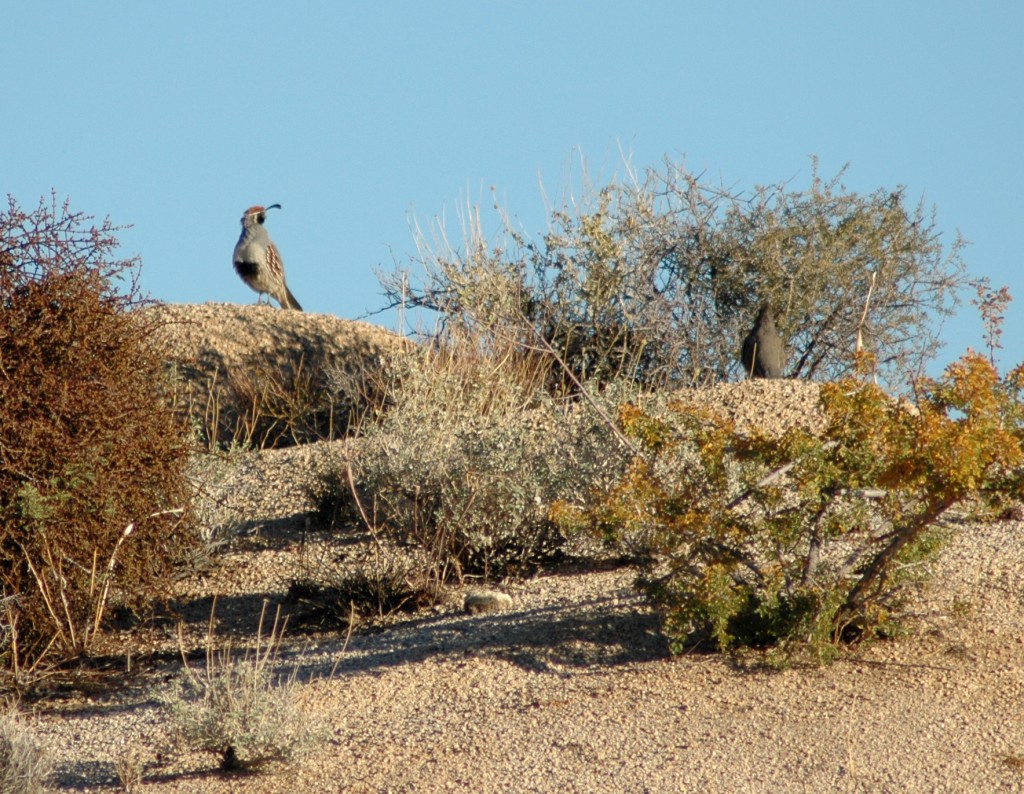
- Gambel’s Quail
Every Desert Site needs a Picture of One of These!
Birdbath & Beyond
American Avocet
Quite a pretty bird, one I had probably seen before, but never really paid attention to. These were in the Saline Valley, one of the most remote and difficult-to-access locations in Death Valley National Park. These birds stand out to me now because someone I talked to said that these birds wandered in during a wet spring and never left; that it was too far to the next body of water that was livable for them, and ultimately, they just began to live here throughout the year. I know better now, however, there is no sense in throwing a good story like that away.
American Avocet

More Birds
Somehow I got off track from the food web and started working on my bird section. It was in need of updating for sure, so I spent sometime bringing that up to speed. While I was there I decided to work on some of my favorites and see what I could do to improve the pages- Mostly just make the pictures larger.
Canada Geese
When I first moved to the Mojave Desert I found it funny to see these at the local lakes. I thought they had been shipped in to add ambiance to the park atmosphere. I was right–They do make it nice in the parks. But they came on their own.
Bird of the Day – Canada goose
As mentioned, I’ve seen these at the local park fishing lake. They certainly aren’t as obnoxious as the domestic white geese there. They will chase you though–and chase you and chase you and chase you. At least that’s what I seen happen to a little boy trying to bully one. I’ll bet that kid doesn’t do it again.
These geese, there were a Momma, Papa, and five or six little goslings on a tiny island made of rocks in the Colorado River. There was a nice backwater flow and I went around the island several times taking pictures. Mom and Dad were concerned but not aggressive . I kept my distance and admired the little family.
I think the strangest place I’ve ever seen geese was at Saratoga Springs at the extreme southern end of Death Valley. I certainly wasn’t expecting that. Now that I know more about these beautiful creatures it doesn’t seem so odd. They were probably just taking a break on their way south.
High Desert Fast Food
A furry, cute little cottontail watches for coyotes, hawks, eagles, bobcats and what-not. It seems everybody loves a cottontail.
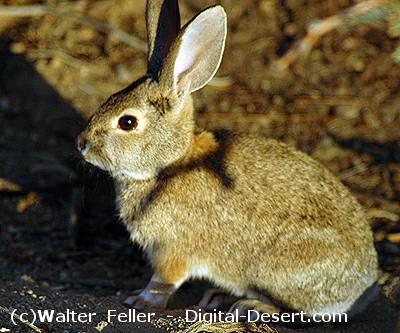
Cottontail rabbit waitin’ to be aten’
The Long Way Around – #47
The Long Way Around – #47: Granite. Granite fascinates me. There’s a lot of it exposed throughout the Mojave. If the Joshua tree is the emblematic plant/tree of the Mojave, then plutonic granite is the symbolic rock. Joshua trees, granite, and rats. Lots and lots of rats–rats everywhere–for the snakes.
I’m not real sure what these are for sure- Mojave (crotalus scutulalus), Southern Pacific (crotalus oreganus helleri), and Speckled (crotalus mitchellii) rattlesnakes, I think. One from out of the area too I believe.
Lizards
My granddaughter Katie, for whatever reason, is good at spotting lizards. We’ll be off somewhere, and I’ll find her paying attention to a rock or branch, and there will be a lizard on it. In this case, a spiny lizard in the Rodman Mountains. I have no such gift–I have better ones. I have grandchildren.
